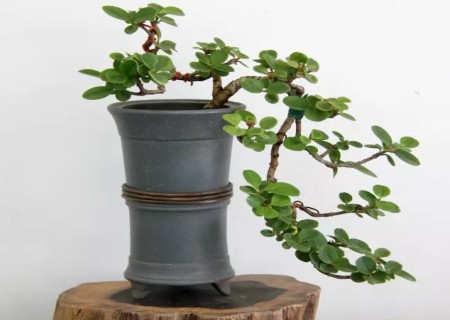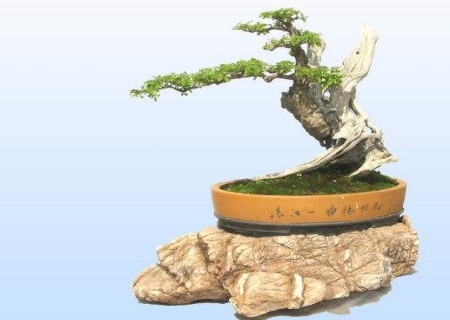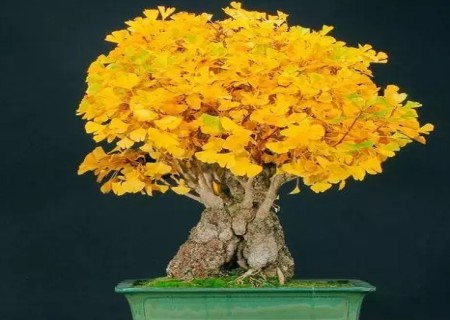Production Technology of Poplar Bonsai
Boxwood, also known as sparrow tongue boxwood, pearl boxwood, its tree shape is beautiful, and thick and accompanied by luster, the most important thing is that boxwood is evergreen all the year round, it is a precious material for bonsai production, it can be made into bonsai masterpieces for the world to watch. If the old yellow poplar piles are excavated from the mountains to create bonsai, its posture will be more simple, natural and exquisite. Since the old poplar stump is a good material for making boxwood bonsai, how can we make such a beautiful boxwood bonsai?

Next, the editor will explain the production technology of boxwood bonsai for you. I hope you can learn this kind of bonsai production technique.
1. Bonsai materials
The materials of boxwood bonsai can be obtained by sowing or cutting propagation, but these two methods take too long to cultivate, and their roots are difficult to shape. Therefore, here we can get the material by digging piles.
Usually, Huang Yang Laozhang can dig all the year round, but the best season for digging is summer. When digging, the root should be hurt as little as possible; after digging, it should be packed in a plastic bag to moisturize.
2. Pile material treatment
Before planting, cut off the main roots below and smear all wounds with pre-purchased latex; at the same time, subtract most of the branches and leaves to prevent the plant from dying from dehydration.
3. Billet cultivation
Before planting in the pot, the treated pile billet needs to be cultured in the open field, and how long it should be cultivated needs to be decided according to the growth of the tree billet. Usually after the billet has been cultivated for 2 years, it can be transplanted into the pot.
4. Transplant into the pot
1) the time of potting is usually between spring and summer, because it is easier for boxwood to survive during this period.
2) before transplanting into the pot, we must first choose a bowl of the right size. What is the right size? That is, the choice of the basin should be decided according to the size and shape of the stump.
3) when putting on the basin, the overgrown and dense roots should be trimmed, of course, it is necessary to rest and recuperate the roots according to the needs of shaping, so that the roots can stretch naturally; as the bonsai stump is made, the depth of planting should not be too deep, and then cover the soil and water once. Finally, move the planted boxwood pot to a cool place, and pay attention to spraying water on the leaves and keeping the potted soil moist. After about a month or so, the plant can be maintained normally when the plant grows obviously.
5. Modeling process
The modeling time of boxwood bonsai should be in summer or autumn, and the techniques of pruning and climbing can be taken. However, whether it is the daily pruning or its modeling, the branches that can not meet the requirements should be treated by "truncation and forced bud", so that the branches will grow in place in order to facilitate modeling.
6. Maintenance and management
1) watering: because the yellow poplar likes the wet environment, it should be watered frequently, if the long-term lack of water will cause the phenomenon of falling leaves.
2) fertilization: in the growing period of Populus tomentosa, nutrients can be properly supplemented in the watering process, with thin rotten cake fertilizer.
3) pruning: in addition to water and fertilizer, we should also prune them properly, mainly to cut off overgrown branches, overlapping branches and extra branches that affect the shape of plants.
4) change the basin: of course, in the process of conservation and management, in order to make the boxwood bonsai grow better and appear in front of the world with the most beautiful posture, we also need to change the basin. It is usually possible to change the pot after 2 years of growth. When changing the basin, it can also be combined with pruning to make it better shape and better reflect the ornamental value of boxwood bonsai.
Time: 2019-05-26 Click:
- Prev

Production Technology of Bauhinia Bonsai
Bauhinia is a common plant in the wild mountains and mountains in the north. What we call bauhinia usually refers to bauhinia. Its trunk is often cracked and rough, looking very simple and vigorous. And its regeneration ability is very strong, not only can withstand strong pruning, but also the branches are very soft and easy to shape, which is very suitable for making bonsai.
- Next

How to make ginkgo bonsai
Summer has come, ginkgo biloba presents a green, with a high ornamental value, so ancient and modern Chinese and foreign people often use ginkgo in the courtyard, street trees or landscaping. However, what the editor wants to tell you today is that ginkgo biloba leaves can be made into bonsai.
Related
- Fuxing push coffee new agricultural production and marketing class: lack of small-scale processing plants
- Jujube rice field leisure farm deep ploughing Yilan for five years to create a space for organic food and play
- Nongyu Farm-A trial of organic papaya for brave women with advanced technology
- Four points for attention in the prevention and control of diseases and insect pests of edible fungi
- How to add nutrient solution to Edible Fungi
- Is there any good way to control edible fungus mites?
- Open Inoculation Technology of Edible Fungi
- Is there any clever way to use fertilizer for edible fungus in winter?
- What agents are used to kill the pathogens of edible fungi in the mushroom shed?
- Rapid drying of Edible Fungi

